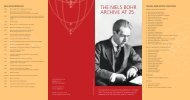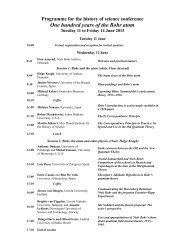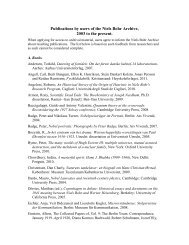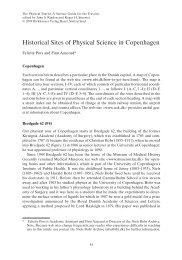Love and physics: Margrethe Nørlund and Niels Bohr's creativity ...
Love and physics: Margrethe Nørlund and Niels Bohr's creativity ...
Love and physics: Margrethe Nørlund and Niels Bohr's creativity ...
You also want an ePaper? Increase the reach of your titles
YUMPU automatically turns print PDFs into web optimized ePapers that Google loves.
Helge Kragh, University of Aarhus, Denmark<br />
The Many Faces of the Bohr Atom<br />
The atomic model that Bohr proposed in 1913 constituted a break with all earlier models of the atom.<br />
However, the break was not complete, for it relied in important respects on the approach of J. J.<br />
Thomson <strong>and</strong> others. Nor was the new picture of the atom fixed. Bohr conceived it as preliminary <strong>and</strong><br />
immediately started developing <strong>and</strong> modifying it. There is a great deal of difference between the Bohr<br />
atom anno 1913 <strong>and</strong> the one of 1924, although there are also significant similarities.<br />
Apart from some remarks of a historiographical nature, my talk offers a general survey of the<br />
development of Bohr’s theory, stressing its relationship to experiments. I intend to evaluate its<br />
significance, both in the scientific communities (<strong>physics</strong>, chemistry) <strong>and</strong> in a broader context. Apart<br />
from the original theory, I will pay particular attention to the “second theory” of 1921-1923 <strong>and</strong> the<br />
much less visualizable version of 1924-1925. Finally, I will take a look beyond 1925, wondering if<br />
Bohr’s theory is truly dead. Perhaps it is, like Schrödinger’s poor cat, half dead <strong>and</strong> half alive?<br />
Michiyo Nakane, Kawasaki, Japan<br />
Bohr’s Introduction to Action-Angle Variables in a 1918 Paper<br />
Action-angle variables provide one of the most important mathematical techniques for quantum theory.<br />
These variables originated in Charlier’s books on celestial mechanics published in 1902 <strong>and</strong> 1907.<br />
Charlier performed a canonical transformation defined by a particular generating function <strong>and</strong> attained<br />
new canonical variables constructed by angle variables <strong>and</strong> action integrals. Noting Charlier’s<br />
argument, Schwarzschild defined action-angle variables <strong>and</strong> used them for an explanation of Stark<br />
effects in 1916. However, he did not present action variables in the form of Ii=∫pidqi, but he noted<br />
variables that have the same dimension as the action integrals that construct canonical variables<br />
together with angle variables, ωi=nit+βi, where t is time, ni is the mean motion, <strong>and</strong> βi is the initial<br />
value of the angle. In a 1918 paper entitled “On the Quantum Theory of Line-Spectra,” Bohr mentioned<br />
that Kramers showed him a way to make Ii <strong>and</strong> ωi canonical conjugates. An origin of formation of<br />
action-angle variables that we find in textbooks of mechanics today first appeared here. Then, Bohr<br />
developed his idea of a conditionally periodic system using the action variables Ii.<br />
9








